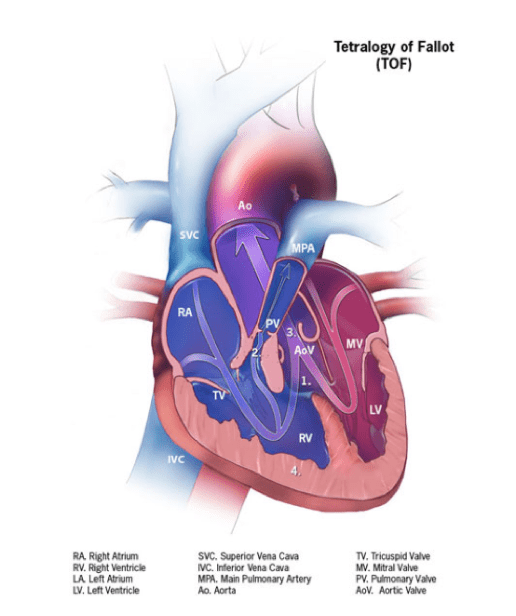Tetralogy of Fallot:
Tetralogy of Fallot (TOF) is a complex congenital condition presenting with four cardiac abnormalities. It is considered a rare condition that may be seen in 1 in 2000 live births in the United States. It is often considered a critical congenital heart abnormality requiring urgent intervention. It will more commonly present at birth or may be diagnosed during perinatal screening where the abnormality may be identified. TOF is commonly associated with chromosomal abnormalities such as Down Syndrome and Di George syndrome.
The four anomalies associated with TOF are:
- Presence of a Ventricular Septal Defect (VSD)
- Stenosis (narrowing) of the pulmonary valve
- Larger aortic valve, that may be associated with Left Ventricular (LV) and Right Ventricular (RV) involvement, located very close to the VSD
- RV hypertrophy or thickening of the muscle

Presentations:
TOF is most commonly seen at birth. If not obvious at birth later clinical signs to be aware of include:
- Cyanosis (bluish tinge to lips, fingers etc)
- Cyanosis during feeding (“TET spells”)
- Failure to thrive
- Increased respiratory rates
- Heart murmur
- Decreased oxygen saturation
- Poor exercise tolerance2.
Treatment of Tetralogy of Fallot
Once TOF is diagnosed (usually post-birth), initial treatment is to treat low oxygen levels. This may then involve reparative cardiac surgery to correct many of the anomalies that are associated with the condition. This may occur in a staged process where there may be one or two procedures depending on many factors such as age, size and condition of the child3.
What is Tetralogy of Fallot?
“1% of babies are born with some form of congenital heart disease, throughout a very large spectrum, a certain proportion of those are born blue which is what we call cyanotic congenital heart disease and the commonest is tetralogy of fallot,” Dr Yishay Orr, Cardiothoracic Surgeon, explains further in the below video. Dr Orr also discusses when and how this defect may present in infants, the treatment options, and potential complications as the child ages.
